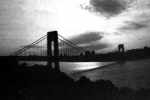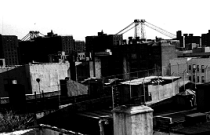
I took the job mainly because I wanted to see what it was like to live and work in New York City. I wanted to have a desk inside a monumental glass skyscraper and buy lunch from a hot dog vendor in front of the Stock Exchange. I didn't think much about what it would be like to work for a huge multinational bank, except that it seemed a kind of unreal thing for me to be doing. The belly of the beast and all that. I'll try anything once.
I quickly discovered that none of my co-workers found working in the financial district the least bit exciting. This puzzled me at first. We were located on one of the most famous streets in the world, the entire city gleamed like Disneyland outside the polished marble walls of our building, yet nobody seemed to care about this at all. In fact, I soon began to notice that everyone I worked with went to great lengths to avoid ever venturing forth into the city, and saved their shopping errands for weekends, when they could peruse the malls of the suburban neighborhoods where they lived.
I found a stunning numbness here, an almost hostile indifference to the beauty of the world outside our office building. I remember walking back to work with my boss after a lunch that lasted too long. We were late for a meeting, and we bumped into a huge crowd that ran all the way from the Stock Exchange to Trinity Church. It turned out there was a ticker tape parade going on for the New York Rangers, who two days earlier had won the Stanley Cup for the first time in fifty years. Do you think my boss stopped to cheer? No, he cursed at the crowd like Ebenezer Scrooge and fought his way to the other side of the street, leading me sheepishly behind.
It isn't just that everybody hates the city; the more time I spend with these people the more I understand that they hate everything. Or at least they seem to, because it is the culture of Wall Street to never show joy. Maybe some of my co-workers lead wonderful lives at home; similarly, I bet some of the Puritans of colonial New England had great sex behind closed doors. In public, though, we are busy, busy, busy.
I don't play along with this. I'm a good programmer and I like to make my projects succeed, but I don't let it ruin my mood when things go wrong or deadlines slip. I also don't take work home with me, and I don't wear a beeper. This may seem normal to you, but on Wall Street this is what is known as a 'bad attitude.' If my technical skills were not in demand I would not be tolerated here at all.
Once after a hysterical meeting in which it was announced that a project had gone over budget and missed a deadline, I broke the mortified silence to say "Well anyway, it's a beautiful day out, so who really gives a fuck?" I do this sort of thing on purpose, just to see what happens. I can now tell you from personal experience that this particular sentiment is met with blank stares and total silence when uttered on Wall Street.
We are only supposed to think about our work. We sit timidly in cubicles and strain to finish our Microsoft Word documents about PowerBuilder applications and Novell Networks so we can send them to each other via Lotus Notes. We allow our software to tug us around by our nose rings like tamed bulls and cows in a mechanical farm, because our software seems to know mysterious things we do not know, because we are terrified of diverging from the proper path and getting into trouble. Those who are already in trouble walk the halls with hollow eyes holding styrofoam cups of coffee, clamoring to rescue themselves by figuring out the meaning of esoteric terms like object-oriented methodology or client-server architecture. They babble insanely about these terms until everybody who listens to them is confused. Eventually these people disappear like dandelions in the fall.
Surrounding all this inanity, there is the city itself. I don't even know why I love New York City as much as I do. I've loved it since I was a kid, when I used to build scale models of the Empire State Building with Lego blocks instead of playing with Matchbox cars. I yearn to know every subway stop, every bodega and playground. I haven't been to Club Med or St. Kitts yet, and when somebody asks me about this I think, why should I go? There are still neighborhoods in the Bronx I haven't visited.
I know a lot of out-of-towners hate the city, and I'll often find myself talking to a visitor from Maine or Oregon or Nebraska who wishes to inform me just exactly how rotten the Big Apple is in his perception. I don't have any problem with this; in fact I think it is a healthy thing for a person to love his own hometown and hate every other place in the world. I'll tell this person in turn what he can do with his redwood trees or soybean silos, and we'll have a grand old time and part the best of friends.
What I do have a problem with is people who don't love their own hometowns. People who sit at their desks and don't look out the windows. People who've worked on Wall Street for ten years and never wandered inside Trinity Church -- who don't even know that they're allowed to wander inside Trinity Church.
Or people who live in New York City and never walk across a bridge. Manhattan's bridges are not the familiar kind of vast sterile structures that connect the interstate highways of America. We have a couple of those, but most of our bridges belong to the streets. They're right around the corner, next to the deli on Delancey Street, beyond a decayed marble entrance on Canal, tucked away behind City Hall. And each bridge has its own unique personality.
 The Queensboro Bridge is gloriously noisy and mechanical. You
walk on metal graters that vibrate as the traffic zooms by. There's
something dangerous and exciting about this sensation. Simon &
Garfunkel sang a song about the Queensboro Bridge
and called it the 59th Street Bridge
Song. "Slow down, you move too fast ..."
The Queensboro Bridge is gloriously noisy and mechanical. You
walk on metal graters that vibrate as the traffic zooms by. There's
something dangerous and exciting about this sensation. Simon &
Garfunkel sang a song about the Queensboro Bridge
and called it the 59th Street Bridge
Song. "Slow down, you move too fast ..."
 The George Washington Bridge is stately and elegant. The pillars
are square-edged and silver. If you walk towards Fort Lee you see the
bridge disappear silently into the trees of the New Jersey cliffs like
a hand into a glove.
The George Washington Bridge is stately and elegant. The pillars
are square-edged and silver. If you walk towards Fort Lee you see the
bridge disappear silently into the trees of the New Jersey cliffs like
a hand into a glove.
 The Williamsburg Bridge glides like a low-flying bat from
Brooklyn near the Navy Yard to Delancey Street on the Lower
East Side of Manhattan. This bridge once belonged to the factory
workers of Brooklyn's industrial waterfront and the Irish and
Italian and Jewish and Chinese immigrants of old New York. Like
these ancestors, it is unglamorous and appears lonely. Its
beauty is harsh and sad.
The Williamsburg Bridge glides like a low-flying bat from
Brooklyn near the Navy Yard to Delancey Street on the Lower
East Side of Manhattan. This bridge once belonged to the factory
workers of Brooklyn's industrial waterfront and the Irish and
Italian and Jewish and Chinese immigrants of old New York. Like
these ancestors, it is unglamorous and appears lonely. Its
beauty is harsh and sad.
 The Manhattan Bridge is art-deco and minimalist. It belongs to
the Jazz Age. I picture Jay Gatsby and Daisy driving on this
bridge during one of their mindless jaunts into New York.
The Manhattan Bridge is art-deco and minimalist. It belongs to
the Jazz Age. I picture Jay Gatsby and Daisy driving on this
bridge during one of their mindless jaunts into New York.
 The Brooklyn Bridge is closest to Wall Street, and it is the masterpiece
of the bunch. The towers are built of brown blocks of
stone. The walkway is laid with wooden planks instead of metal
graters, and it goes down the center of the bridge, elevated
above the cars. On this bridge, for once, the walker feels more
important than the driver.
The Brooklyn Bridge is closest to Wall Street, and it is the masterpiece
of the bunch. The towers are built of brown blocks of
stone. The walkway is laid with wooden planks instead of metal
graters, and it goes down the center of the bridge, elevated
above the cars. On this bridge, for once, the walker feels more
important than the driver.
You've seen the design of the cables in cubist paintings and Absolut Vodka ads. You can walk right up to one of the towers and look up: the sky is cut into a thousand polygons above you. The polygons shift as you walk. You look back at Manhattan and see that the city is reduced to a mere element in a greater tableau. The stark boxes of the World Trade Center, the marble edifices around City Hall, the gleaming modern skyscrapers of Wall Street and South Street ... they bloom silently. The blue waters of the East River lap restlessly below.
Stand here, and it is impossible to care about a project or a deadline. Water is the antithesis of anxiety; it is inexorable and has no cohesion, but it travels with the strength of karma. To look at water, to grasp its rhythm and feel its flow, is to be calmed.
I stare at the East River during an annoying day at work, and I feel my life trickle back into my body like sap dripping backwards into a tree.
This is how I stay sane on Wall Street. These are the bridges of New York City.